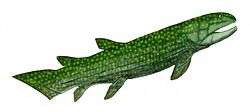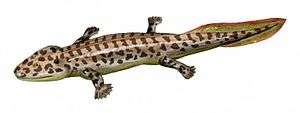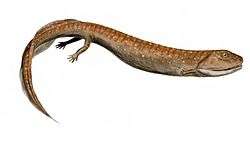Umzantsia
Umzantsia is a genus of extinct tetrapod from the Devonian of South Africa, containing a single species, Umzantsia amazana. It was described from the +/- 360 myo Gondwana locality of Waterloo Farm lagerstätte on the south-eastern coast of South Africa, which at the time was located within the Antarctic Circle. Together with the find of Tutusius umlambo from the same locality, this provides the first evidence that Devonian tetrapods were not restricted to the tropics as was formerly believed, and suggests that they may have been global in distribution. Waterloo Farm fossils have been metamorphosed and intensely flattened, with the bone tissue replaced by secondary metamorphic mica that is partially altered to kaolinite and chlorite during uplift. They also provide the first evidence of Devonian tetrapods from the continent of Africa, and only the second and third such taxa from Gondwana.[1][2]
| Umzantsia | |
|---|---|
 | |
| Reconstructed outline | |
| Scientific classification | |
| Kingdom: | Animalia |
| Phylum: | Chordata |
| Clade: | Stegocephalia |
| Genus: | †Umzantsia Gess & Alberg, 2018 |
| Type species | |
| †Umzantsia amazana Gess & Ahlberg, 2018 | |
Etymology
The generic name is derived from isiXhosa “uMzantsi”, meaning “south” (also “South Africa”), referring to its place of origin. The specific name “amazana” means “water ripples”, referring to its distinctive dermal ornament.[1]
Description
Dermal bones of Umzantsia carry a distinctive ornament consisting of fine parallel ridges reminiscent of water ripples. This allows identification of a number of cranial bones and a cleithrum from one bedding plane which are probably derived from a single individual. The dermal ornament covers about 80% of the cleithrum of Umzantsia; this fishlike characteristic contrasts with the un-ornamented cleithra of most other Devonian tetrapods, suggesting a phylogenetic position between those tetrapods and their sister group, the Elpistostegalians. The only other tetrapod with dermal ornaments on the cleithrum is Parmastega though it covers far less of the cleithrum. The cleithrum tapers to a point anteroventrally and carries a single attachment scar for the scapulocoracoid, which extends along the anteroventral process, forms a v-shaped dorsal peak, and ends posteriorly in a projecting buttress. The blade of the cleithrum carries a semicircular posterodorsal extension. The jugal (cheek bone beneath the eye) extends anterior to the orbit and contacts the prefrontal. The jugal has a very short orbital margin and lacks a distinct dorsal postorbital process. A decayed lower jaw from a different individual of the same species was also described.[1][2]
References
- Gess, R.; Ahlberg, P. E. (2018). "A tetrapod fauna from within the Devonian Antarctic Circle". Science. 360 (6393): 1120–1124. doi:10.1126/science.aaq1645.
- "First tetrapods of Africa lived within the Devonian Antarctic Circle". Johannesburg: University of Witwatersrand. June 2018.






